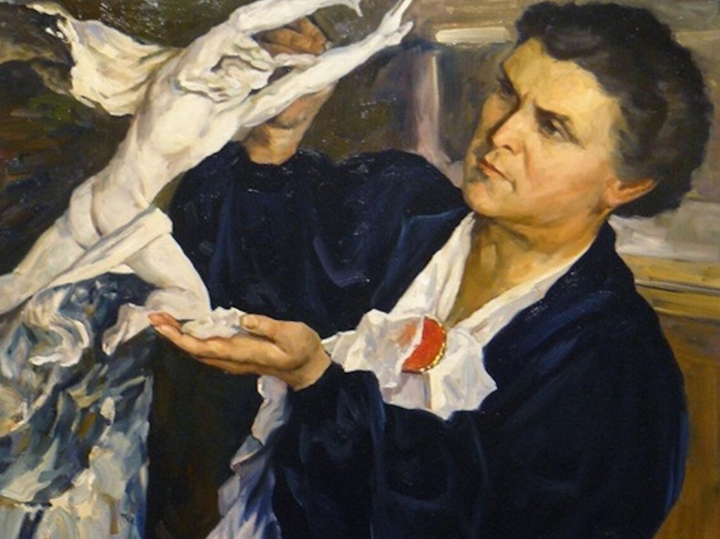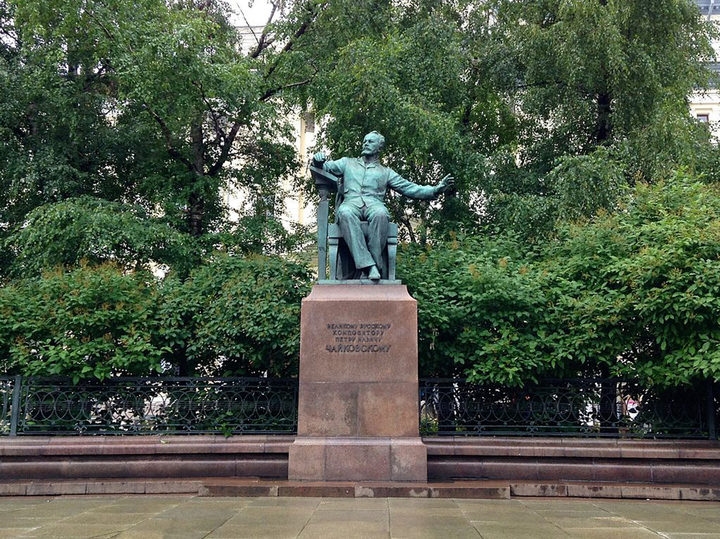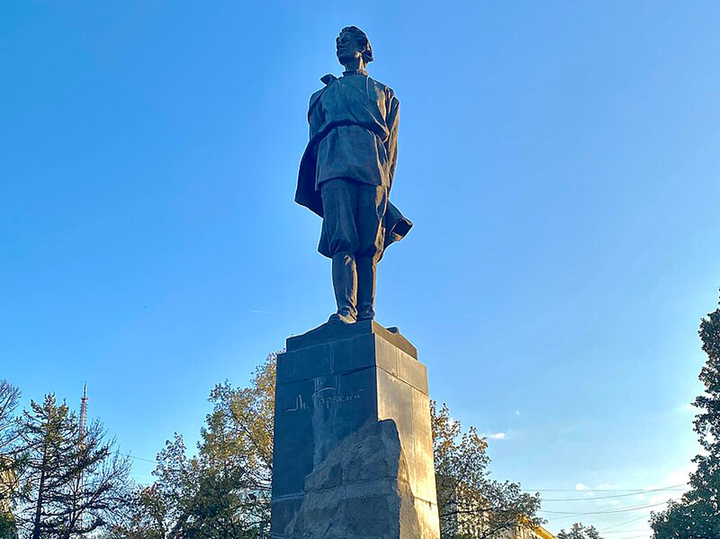It became known that sculptor Vera Mukhina wrote in her will: “The work is worthy of Moscow”
[ad_1]
Vera Mukhina is remembered today primarily as the author of the statue “Worker and Collective Farm Woman,” which decorated the Soviet pavilion at the World Exhibition in Paris in 1937, and then returned to the Soviet Union and a year later was installed in Moscow near VDNKh. After some time, this sculpture became the emblem of the Mosfilm film studio.
The list of noteworthy works by Mukhin includes a legendary object familiar to all residents of the USSR, widely used in everyday life – a cut glass. It was Vera Ignatievna who developed its form, which has become classic.
Although the glass itself appeared in the era of Peter the Great, our ancestors made it by hand. And Mukhina, in the fall of 1943, changed the proportions of this drinking vessel, narrowed it downwards, made a smooth upper rim and worked with the external design of the edges. The resulting glass, so familiar to all residents of the country, now had a standard volume of 200 ml. So we had a reason to celebrate the 80th anniversary of this item, which is so in demand among the general population.
By the way, later the same sculptor V. Mukhina also came up with the shape of beer mugs, popular in the Soviet Union.
In the fall of 1953, Vera Ignatievna became seriously ill. Anticipating her imminent departure, she sent a farewell letter – essentially, a will – to one of the country’s leaders, Vyacheslav Molotov (it was now kept in the Russian State Archive of Contemporary History).
Why did the sculptor turn specifically to Molotov? The fact is that he had previously saved her from arrest more than once. It is known that in the spring of 1937, the NKVD received a denunciation against Mukhina. Vera Ignatievna was accused of sabotage and sabotage. The “vigilant” authors of this paper argued that the sculpture “Worker and Collective Farm Woman,” at the author’s behest, has a secret anti-Soviet meaning: in the folds of the collective farmer’s sundress, the facial features of the “enemy of the people” Trotsky are visible.

Two members of the Politburo took charge of checking the denunciation: Vorotnikov and Molotov. They arrived at the factory where both huge sculptures were being made. The first of these high-ranking party members gave instructions to remove the bags under the eyes of the collective farmer. But Molotov allowed the collective farmer’s sundress to be left in its original form, without finding even a hint of anyone’s portrait there. But he suggested removing the fluttering scarf she was holding in her hand. However, Mukhina convinced Vyacheslav Mikhailovich that the scarf was needed to balance the entire sculptural group.
By the way, Molotov himself did not leave written memories of his meetings with Vera Ignatievna. Only towards the end of his life, during one of his conversations with the poet Felix Chuev, he somehow casually mentioned that he had been at Mukhina’s exhibition when the sculptor was just working on her famous composition, and he was surprised that both figures—the worker, and the collective farmer were naked. “I,” Molotov admitted to Chuev, “asked to put them on after all.”
In some cases, when even Molotov was powerless, Mukhina was forced to turn to Stalin himself. Her letter to the leader, sent on May 12, 1946, has been preserved in the party archives. The sculptor complained that she made designs for monuments to Gorky, the Chelyuskinites, the defense of Sevastopol, aviation, Tchaikovsky, as well as three versions of sculptural groups for the Moskvoretsky Bridge and the Fountain of Nationalities. “Not one of them was staged,” Mukhina wrote to Stalin, “not because they were rejected, but simply because they were not reviewed by those who had the right to approve them for production.”
This complaint reached the then chief ideologist of the party, Andrei Zhdanov. He gave instructions to the Chairman of the Committee for Arts Mikhail Khrapchenko and the head of Agitprop of the Central Committee of the All-Union Communist Party of Bolsheviks Georgy Alexandrov: “Read Mukhina’s letter. She deserves all the attention. Let me know how you think the issues raised by Comrade Mukhina should be resolved.” But Khrapchenko sent Zhdanov a very evasive answer. He said that of all Mukhina’s works, the authorities accepted only the monument to Gorky, while other works were either not ordered from her, or were completed unsuccessfully, and he proposed to consider the project of the monument to Tchaikovsky in the Central Committee.
Let us emphasize that Khrapchenko, despite everything, was not the worst manager. After him, the Committee for Arts was headed by Polykarp Lebedev. This is exactly who turned out to be a militant ignorant and spread rot on Mukhina for a very long time.

At one time, Marshal Voroshilov supervised cultural issues in the government. But Mukhina preferred, when she had troubles, to still seek support from Molotov. She considered this high-ranking functionary to be the most knowledgeable person in matters of art in the entire government.
In her dying letter, Mukhina asked Vyacheslav Mikhailovich: “Don’t forget fine art, it can give the people no less than cinema or literature. Don’t be afraid to take risks in art: without continuous, often erroneous searches, we will not grow our own new art.”
Although Vera Ignatievna was awarded the Stalin Prize five times during her lifetime, she often had to deal with misunderstanding and even denial of her work in the corridors of power. Is this why, in the letter already mentioned, she drew Molotov’s attention to the dominance in the departments responsible for culture of retrogrades and simply ignoramuses? “Clean up the art management apparatus,” many of its leaders, instead of helping artists, drive them to death; sometimes they take bribes.”
True, the sculptor did not name any specific names of the bribe takers. Why? It is known for sure that for many years Mukhina was interfered with in every possible way by the head of the fine arts department in the Committee for Arts Affairs, Pyotr Sysoev. Wasn’t it him that Vera Ignatievna suggested “cleaning”?
Her third request, stated in a letter to Molotov, concerned the long-suffering monument to Pyotr Tchaikovsky. Mukhina has been working on it since the late 1920s. First, she made a bust of the composer for a museum in Klin, near Moscow. And in the year of Victory, she received a personal order to create a monument to the author of “Swan Lake” for Moscow from the All-Union Committee for Arts.
Mukhina wanted to portray Pyotr Ilyich conducting while standing. But high-ranking officials made it clear to the sculptor that no one would allocate an entire square for a monument to her in the capital. It was necessary to fit the entire composition into the small courtyard in front of the conservatory. And then Mukhina decided to sit her Tchaikovsky in a chair in front of a music stand with an open music book.
The Art Council of the Committee on Arts approved the sculptor’s work only in February 1947. But unexpectedly, a group of composers came out with criticism of this monument. Shebalin, Asafiev and their comrades found the figure of a shepherd playing a flute built into the composition of the monument questionable. Under pressure from these “representatives of musical circles,” the chairman of the committee, Khrapchenko, wavered.
To save her job, Mukhina gave up being a shepherdess. However, Lebedev, who took the place of the dismissed Khrapchenko, blocked the installation of the monument just in case.
In the fall of 1953, Mukhina, knowing that she only had a few days left to live, asked in a letter to Molotov: “Stage my Tchaikovsky in Moscow. You may remember how at the screening of “The Worker and the Collective Farm Woman” we argued and you finally believed me, believed the artist’s instincts. I guarantee you that this work of mine is worthy of Moscow.”

In addition to the monument to Tchaikovsky, Vera Ignatievna was worried about the fate of four more sculptures on which she worked: “Water”, “Earth”, “Fertility” and “Bread”. Mukhina wanted these sculptures to be installed in pairs in the squares of some Volga cities. At the same time, the sculptor asked to allocate the necessary amount of bronze in order to cast several works she completed from this metal.
Vera Ignatievna’s last request concerned the family of her son Vsevolod Mukhin (he remained at his alma mater after graduating from the Faculty of Physics at Moscow State University). “I beg you very much,” the sculptor wrote to Molotov, “to make sure that it (the apartment-workshop. – V.O.) remains with my guys and that it does not cost them exorbitant amounts of money, since they have not yet fully matured. “
The letter to Molotov ended with these words: “… in death, as in life, always yours, V. Mukhina.” And the date: “September 26, 1953.”
This talented woman sculptor died ten days later, late in the evening of October 6. Literally a few hours later, the son sent his mother’s will to Molotov. In the accompanying note he wrote: “Dear Vyacheslav Mikhailovich. My mother, Vera Ignatievna Mukhina, died today at 22:30. I hasten to fulfill her last request.”
On October 8, Molotov ordered Mukhina’s farewell message to be sent to all members of the Presidium of the CPSU Central Committee. “I propose,” he told his colleagues at the top of the party, “to instruct the Secretariat of the Central Committee to consider V. Mukhina’s note.”
On October 10, all materials were received by one of the secretaries of the Central Committee, Mikhail Suslov. He gave instructions to the first deputy head of the Department of Science and Culture of the Central Committee, Fyodor Khrustov: “Carefully look into the questions posed in V.I. Mukhina’s letter and prepare a proposal.”
On November 2, 1953, the Secretariat of the Central Committee approved the draft corresponding resolution of the Council of Ministers of the USSR. It was allowed to assign the name of V.I. Mukhina to the Leningrad Higher Art and Industrial School and install a memorial plaque in Moscow at 5a on Ostrovsky Lane, where the sculptor lived and worked (at the same time, officials did not leave all the premises in this building for the family of Mukhina’s son, but only the residential part of the workshop). The Ministry of Culture was instructed to submit a proposal to install a Mukhina monument to Tchaikovsky, as well as to organize a posthumous exhibition of the sculptor.
Let us note an interesting fact. The approval of the Secretariat of the Central Committee was not enough. All of the above-mentioned events still required the consent of the Presidium of the Central Committee. And this highest party authority gave its “go-ahead” only on November 9, 1953.
[ad_2]
Source link






